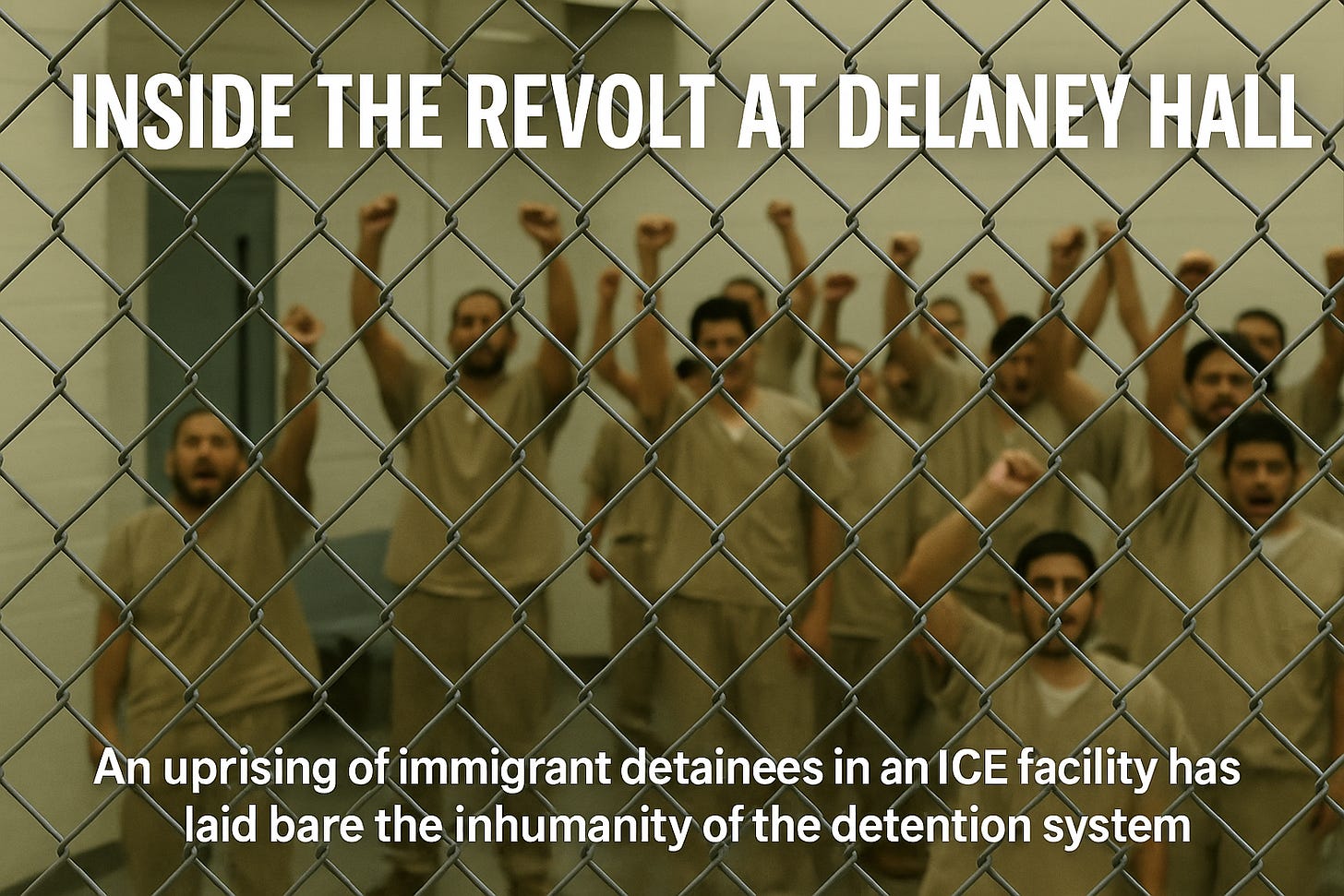Tear Down the Real Walls: What the Revolt at Delaney Hall Means for All of Us
Starved, silenced, and criminalized, detained migrants in Newark rebelled against a system built to disappear them.
It started with hunger. Inside Delaney Hall, a privately run ICE detention center tucked in Newark, New Jersey, nearly 50 detainees were left without food for more than 20 hours. No explanation. No apology. Just locked doors, grumbling stomachs, and the rising heat of desperation. On June 12, they broke.
The uprising began as a protest with detainees pounding on doors, shouting for basic needs. It escalated when they tore down a thin interior wall, exposing just how brittle the foundation of America’s detention regime really is. In the chaos, four detainees escaped. Federal agents scrambled. Helicopters circled. Tear gas filled the halls. A fire reportedly broke out inside. Outside, protesters clashed with officers as they demanded accountability for conditions that had long been ignored.
You likely didn’t see this on the evening news.
This isn’t just about an escape. It’s about a system built on profit, secrecy, and neglect. It’s about the deliberate dehumanization of migrants, the consequences of privatized detention, and the return of Trump-era cruelty rebranded for 2025. The wall at Delaney Hall cracked. What poured out wasn’t just fear and chaos—it was the truth.
And if we don’t face it now, more walls will break, and more people will suffer.
Independent News. Just $1/Week.
We just hit 15,000 subscribers—thank you! To celebrate, we’re offering full access to The Coffman Chronicle for 50% OFF!
Get exclusive analysis, daily rundowns, and fearless reporting you won’t find in corporate media.
Support truth. Stay informed.
When Hunger Becomes Resistance
What happened at Delaney Hall wasn’t a riot. It was a response of last resort.
Inside the facility, detainees reportedly went without food for nearly an entire day. For people already surviving on meager portions in an overcrowded, high-stress environment, the missing meals weren’t just a bureaucratic hiccup—they were a threat to health and dignity. Detainees banged on walls. They shouted for help. Nothing came. Hunger turned into hopelessness. Hopelessness turned into action.
When nearly 50 detainees tore down an internal wall, it wasn’t an attempt to escape justice. It was a demand to be seen as human beings, not bodies on a ledger. That wall, made of drywall and hollow partitions, was never meant to keep people in. It was meant to make them invisible. The revolt shattered that illusion.
This wasn’t the first time detainees inside ICE facilities used hunger as protest. Across the country, immigrant detainees have launched hunger strikes over unsafe water, medical neglect, cold temperatures, and verbal abuse. At Adelanto, Pine Prairie, Otay Mesa, and now Delaney Hall, hunger has become the language of the ignored.
Yet ICE and its contractors rarely face consequences. Private companies like GEO Group operate in shadows, where transparency is optional and accountability is someone else’s job. When food disappears for 20 hours, so do the records. So does the truth, until the people inside rise up and force the country to look.
They weren’t revolting against America. They were revolting against being forgotten by it.
Delaney Hall has been covered in our reporting previously. See some of that coverage here:
Note: This article is more than 45 days old and now lives in the archive. Consider becoming a paid subscriber for the full 650+ article archive, exclusive content, and occasional early access.
The Company Behind the Collapse: GEO Group and the Business of Misery
Delaney Hall didn’t fail by accident. It failed by design.
The facility is operated by the GEO Group, one of the largest private prison contractors in the United States. This is the same company that has been sued for forced labor, condemned by human rights groups, and repeatedly accused of cutting corners on food, healthcare, and staffing all while pocketing millions in taxpayer dollars. At Delaney Hall, GEO wasn’t just running a detention center. It was running a profit center.
Newark officials warned about this. When the facility reopened earlier this year under a new federal contract, it lacked proper inspections, valid permits, or local approval. Newark Mayor Ras Baraka tried to visit and was arrested. Rep. LaMonica McIver sounded alarms. ICE and GEO Group didn’t care. The contract was signed. The checks were cleared.
What GEO provides isn’t safety or order—it’s the appearance of compliance. Thin walls. Understaffed posts. A food contractor with no obligation to transparency. When meals didn’t arrive for 20 hours, no one was held accountable. When the wall collapsed, DHS blamed detainees, not the blueprint.
Privatized detention has become a convenient fiction: the government can claim distance, the company claims efficiency, and the public gets silence. But inside, the math is simple: less food = more margin. Fewer guards = higher profits. Human suffering becomes just another line item to minimize.
The revolt at Delaney Hall exposed more than just a breach. It exposed what happens when incarceration is industrialized, when human lives become units on a balance sheet.
And as long as GEO profits from cages, it will always be cheaper to ignore suffering than to stop it.
Trump’s ICE 2.0: Cruelty as Campaign Strategy
Delaney Hall didn’t explode in a vacuum; it’s a pressure cooker built by policy.
Under Trump’s second term, ICE has been unleashed with even greater impunity. Executive orders signed in early 2025 massively expanded federal contracts with private detention providers like GEO Group. Oversight mechanisms were stripped. Congressional inquiries were stonewalled. And once again, cruelty became the point, not a failure of the system, but its design.
Delaney Hall reopened under this renewed vision: mass detention with minimal oversight, funneled through private hands. That’s how a facility with no local approval, no public hearings, and no food for 20 hours ended up housing dozens of detainees in conditions so desperate that they rebelled.
It wasn’t just the detainees who were punished for asking questions. When Newark Mayor Ras Baraka attempted a surprise inspection after receiving complaints from inside the facility, he was arrested. When Rep. LaMonica McIver joined protests outside the gates, she was detained and later indicted over fabricated allegations. This wasn’t law enforcement; it was message-sending: dissent will be criminalized.
See our reporting on that story here:
All of this is consistent with Trump’s broader agenda: use the machinery of the state to dominate and disappear the vulnerable. ICE has become his enforcement arm, not just for immigration, but for intimidation. Whether it’s raiding churches, surveilling activists, or starving detainees into revolt, the goal is the same: to make the costs of crossing the border—or questioning the regime—intolerably high.
The uprising at Delaney wasn’t just about food. It was about power. It was about who gets to eat, who gets to speak, and who gets locked away when they refuse to be silent.
Delaney Hall was the pilot program. The blueprint is already being scaled.
A Pattern, Not a Fluke
Delaney Hall is not an outlier; it’s part of a chilling pattern.
From California to Georgia, ICE detention centers have long been hotbeds of abuse. Hunger strikes at Adelanto, mass COVID neglect at Otay Mesa, forced hysterectomies at Irwin County Detention Center, freezing conditions at Hudson County Jail—the list is long, and the cruelty consistent. What connects these cases isn’t just the suffering, but the impunity.
Delaney Hall is just the latest headline in a timeline that includes Adelanto, Irwin, Otay Mesa. Different locations, same blueprint. Each case reveals the same structural design: warehouse human beings, dodge accountability, and treat suffering as the cost of doing business.
Time and again, detainees report unsanitary conditions, spoiled food, denial of medical care, and violent retaliation for speaking out. Watchdog reports document it. Congressional hearings acknowledge it. And still, the same companies—GEO Group, CoreCivic, and their web of subcontractors—keep winning lucrative federal contracts.
Delaney Hall simply pulled back the curtain a little more.
Its revolt was sparked by hunger, but fed by a deeper rot: the normalization of cruelty, the outsourcing of accountability, and the political weaponization of fear.
There’s a reason why these abuses keep recurring. Because no one is ever truly held accountable. When detainees go on hunger strike, ICE labels them “noncompliant.” When detainees protest starvation, DHS blames “criminal behavior.” When detainees tear down a wall, the media runs mugshots instead of asking: Why were they pushed to this point?
What happened at Delaney Hall wasn’t chaos—it was clarity. A system like this doesn’t break; it functions precisely as it was built.
And what we saw in Newark is what happens when you push desperate people into cages and hope the drywall holds.
It never does.
The Public’s Silence & the Cost of Looking Away
For all its urgency, the Delaney Hall revolt barely registered in the national conversation. No front-page headlines, no primetime news panels, no presidential statements. In a country that never stops arguing about immigration, it’s telling how quiet things get when those most impacted are locked away, starving, and finally fighting back.
We treat detention centers like distant islands, places we can ignore because they’re behind fences, run by contractors, or buried in legalese. But the people inside are not abstractions. They are fathers, daughters, asylum seekers, and workers. Many haven’t even been charged with crimes. Some were picked up in raids, others for overstaying a visa. And all of them are now caught in a system that sees them not as human, but as a logistical problem to be warehoused and forgotten.
And that silence is exactly what this system depends on to keep functioning in the dark. It’s not just apathy; it’s operational cover.
When a prison denies food for 20 hours, and no headlines follow, the system learns it can keep doing it. When four people escape hunger and confinement and the media responds with mugshots instead of questions, the message is clear: their lives only matter if they break the narrative. When elected officials are arrested or indicted for demanding answers, the public learns not to ask.
We like to think we’d stand up against injustice if it happened in our name. But it is happening in our name, with our tax dollars, on our soil.
The cruelty isn’t new. The revolt isn’t shocking. What’s shocking is how many people will look away.
The truth is, no wall can contain the consequences of dehumanization. What we don’t confront, we condone. And what we ignore today will return tomorrow—louder, bloodier, more uncontainable.
Because nothing stays hidden forever. Not hunger. Not fire. Not the truth.
Tear Down the Real Walls
The uprising at Delaney Hall was a warning. Not just about one facility, one company, or one administration, but about the direction of this country.
When hunger is used as a weapon, when drywall becomes a prison wall, when mayors and members of Congress are arrested for asking questions, we are no longer talking about isolated incidents. We are talking about authoritarianism in motion. We are talking about a country that is testing how much cruelty the public will tolerate before it fights back.
This cannot be normalized. Not by the media. Not by lawmakers. And not by you.
Here’s what you can do right now:
Demand the closure of Delaney Hall and all privately run ICE detention centers.
Support the Dignity for Detained Immigrants Act which would ban private detention and restore due process.
Donate to local legal aid groups, bond funds, and immigrant justice coalitions.
Amplify stories like Delaney Hall’s. If the media won’t lead, then we must.
Call your member of Congress today. Capitol Switchboard: (202) 224-3121
Here's a script:
“Hi, my name is [Your Name], and I’m a constituent. I’m calling to demand an end to for-profit immigrant detention and the immediate investigation and closure of Delaney Hall. No human being should be starved, silenced, or caged for profit. I expect you to take a stand.”
This isn’t just about immigrants. It’s about the soul of the country we’re becoming.
The real walls aren’t made of concrete. They’re built from apathy. From profit. From the silence of good people waiting for someone else to speak up.
Tear. Them. Down.
We just hit 15,000 subscribers—thank you!
Get exclusive access for just $1/week or $52 a year.
Get exclusive analysis and fearless reporting you won’t find in corporate media.
Bibliography:
“4 Detainees Have Escaped from an Immigration Detention Center in Newark, New Jersey, DHS Says.” AP News, June 13, 2025.
“Intento de motín en Delaney Hall: inmigrantes encarcelados en el centro de detención protestan por la falta de comida.” El País, June 13, 2025.
“Detainees at New Jersey Immigration Center Revolt as Chaos Unravels.” The Guardian, June 13, 2025.
“Four Escape Migrant Detention Center in Newark, Authorities Say.” The Washington Post, June 13, 2025.
“Detainees in Newark immigration facility may be relocated after some escaped.” USA Today, June 13, 2025.
“Four Detainees Escape Newark ICE Facility, Homeland Security Says.” The Wall Street Journal, June 13, 2025.
“Inside the Tumult That Led 4 Men to Escape from a Migrant Facility.” The New York Times, June 13, 2025.











We are bringing the news the Legacy Media won't cover!! Thanks for the kind words.
You are so invaluable to us at this time of egregious, inhumane treatment of humans and denial of rights now known to people who can access the information! Keep up the fantastic work!!!!!